10: Recontact
- Page ID
- 8290
\( \newcommand{\vecs}[1]{\overset { \scriptstyle \rightharpoonup} {\mathbf{#1}} } \)
\( \newcommand{\vecd}[1]{\overset{-\!-\!\rightharpoonup}{\vphantom{a}\smash {#1}}} \)
\( \newcommand{\dsum}{\displaystyle\sum\limits} \)
\( \newcommand{\dint}{\displaystyle\int\limits} \)
\( \newcommand{\dlim}{\displaystyle\lim\limits} \)
\( \newcommand{\id}{\mathrm{id}}\) \( \newcommand{\Span}{\mathrm{span}}\)
( \newcommand{\kernel}{\mathrm{null}\,}\) \( \newcommand{\range}{\mathrm{range}\,}\)
\( \newcommand{\RealPart}{\mathrm{Re}}\) \( \newcommand{\ImaginaryPart}{\mathrm{Im}}\)
\( \newcommand{\Argument}{\mathrm{Arg}}\) \( \newcommand{\norm}[1]{\| #1 \|}\)
\( \newcommand{\inner}[2]{\langle #1, #2 \rangle}\)
\( \newcommand{\Span}{\mathrm{span}}\)
\( \newcommand{\id}{\mathrm{id}}\)
\( \newcommand{\Span}{\mathrm{span}}\)
\( \newcommand{\kernel}{\mathrm{null}\,}\)
\( \newcommand{\range}{\mathrm{range}\,}\)
\( \newcommand{\RealPart}{\mathrm{Re}}\)
\( \newcommand{\ImaginaryPart}{\mathrm{Im}}\)
\( \newcommand{\Argument}{\mathrm{Arg}}\)
\( \newcommand{\norm}[1]{\| #1 \|}\)
\( \newcommand{\inner}[2]{\langle #1, #2 \rangle}\)
\( \newcommand{\Span}{\mathrm{span}}\) \( \newcommand{\AA}{\unicode[.8,0]{x212B}}\)
\( \newcommand{\vectorA}[1]{\vec{#1}} % arrow\)
\( \newcommand{\vectorAt}[1]{\vec{\text{#1}}} % arrow\)
\( \newcommand{\vectorB}[1]{\overset { \scriptstyle \rightharpoonup} {\mathbf{#1}} } \)
\( \newcommand{\vectorC}[1]{\textbf{#1}} \)
\( \newcommand{\vectorD}[1]{\overrightarrow{#1}} \)
\( \newcommand{\vectorDt}[1]{\overrightarrow{\text{#1}}} \)
\( \newcommand{\vectE}[1]{\overset{-\!-\!\rightharpoonup}{\vphantom{a}\smash{\mathbf {#1}}}} \)
\( \newcommand{\vecs}[1]{\overset { \scriptstyle \rightharpoonup} {\mathbf{#1}} } \)
\( \newcommand{\vecd}[1]{\overset{-\!-\!\rightharpoonup}{\vphantom{a}\smash {#1}}} \)
\(\newcommand{\avec}{\mathbf a}\) \(\newcommand{\bvec}{\mathbf b}\) \(\newcommand{\cvec}{\mathbf c}\) \(\newcommand{\dvec}{\mathbf d}\) \(\newcommand{\dtil}{\widetilde{\mathbf d}}\) \(\newcommand{\evec}{\mathbf e}\) \(\newcommand{\fvec}{\mathbf f}\) \(\newcommand{\nvec}{\mathbf n}\) \(\newcommand{\pvec}{\mathbf p}\) \(\newcommand{\qvec}{\mathbf q}\) \(\newcommand{\svec}{\mathbf s}\) \(\newcommand{\tvec}{\mathbf t}\) \(\newcommand{\uvec}{\mathbf u}\) \(\newcommand{\vvec}{\mathbf v}\) \(\newcommand{\wvec}{\mathbf w}\) \(\newcommand{\xvec}{\mathbf x}\) \(\newcommand{\yvec}{\mathbf y}\) \(\newcommand{\zvec}{\mathbf z}\) \(\newcommand{\rvec}{\mathbf r}\) \(\newcommand{\mvec}{\mathbf m}\) \(\newcommand{\zerovec}{\mathbf 0}\) \(\newcommand{\onevec}{\mathbf 1}\) \(\newcommand{\real}{\mathbb R}\) \(\newcommand{\twovec}[2]{\left[\begin{array}{r}#1 \\ #2 \end{array}\right]}\) \(\newcommand{\ctwovec}[2]{\left[\begin{array}{c}#1 \\ #2 \end{array}\right]}\) \(\newcommand{\threevec}[3]{\left[\begin{array}{r}#1 \\ #2 \\ #3 \end{array}\right]}\) \(\newcommand{\cthreevec}[3]{\left[\begin{array}{c}#1 \\ #2 \\ #3 \end{array}\right]}\) \(\newcommand{\fourvec}[4]{\left[\begin{array}{r}#1 \\ #2 \\ #3 \\ #4 \end{array}\right]}\) \(\newcommand{\cfourvec}[4]{\left[\begin{array}{c}#1 \\ #2 \\ #3 \\ #4 \end{array}\right]}\) \(\newcommand{\fivevec}[5]{\left[\begin{array}{r}#1 \\ #2 \\ #3 \\ #4 \\ #5 \\ \end{array}\right]}\) \(\newcommand{\cfivevec}[5]{\left[\begin{array}{c}#1 \\ #2 \\ #3 \\ #4 \\ #5 \\ \end{array}\right]}\) \(\newcommand{\mattwo}[4]{\left[\begin{array}{rr}#1 \amp #2 \\ #3 \amp #4 \\ \end{array}\right]}\) \(\newcommand{\laspan}[1]{\text{Span}\{#1\}}\) \(\newcommand{\bcal}{\cal B}\) \(\newcommand{\ccal}{\cal C}\) \(\newcommand{\scal}{\cal S}\) \(\newcommand{\wcal}{\cal W}\) \(\newcommand{\ecal}{\cal E}\) \(\newcommand{\coords}[2]{\left\{#1\right\}_{#2}}\) \(\newcommand{\gray}[1]{\color{gray}{#1}}\) \(\newcommand{\lgray}[1]{\color{lightgray}{#1}}\) \(\newcommand{\rank}{\operatorname{rank}}\) \(\newcommand{\row}{\text{Row}}\) \(\newcommand{\col}{\text{Col}}\) \(\renewcommand{\row}{\text{Row}}\) \(\newcommand{\nul}{\text{Nul}}\) \(\newcommand{\var}{\text{Var}}\) \(\newcommand{\corr}{\text{corr}}\) \(\newcommand{\len}[1]{\left|#1\right|}\) \(\newcommand{\bbar}{\overline{\bvec}}\) \(\newcommand{\bhat}{\widehat{\bvec}}\) \(\newcommand{\bperp}{\bvec^\perp}\) \(\newcommand{\xhat}{\widehat{\xvec}}\) \(\newcommand{\vhat}{\widehat{\vvec}}\) \(\newcommand{\uhat}{\widehat{\uvec}}\) \(\newcommand{\what}{\widehat{\wvec}}\) \(\newcommand{\Sighat}{\widehat{\Sigma}}\) \(\newcommand{\lt}{<}\) \(\newcommand{\gt}{>}\) \(\newcommand{\amp}{&}\) \(\definecolor{fillinmathshade}{gray}{0.9}\)We all learned as children that Columbus "discovered" America on October 12, 1492. But as we discussed in the last chapter, important human interactions with the American environment had been going on for millennia when Europeans first made their way to the “New World.” In recent years, some historians have retold the traditional story of European exploration with an emphasis on the brutality of groups like the conquistadors. Indian activists have called for boycotts of Columbus Day and Thanksgiving. Our goal here is not to choose sides, but to recognize environmental factors that influenced the course of events. Some of these factors were introduced in the last chapter. The shapes and placement of continents on our planet, and the climate changes surrounding the ice ages influenced the development of civilizations in both Eurasia and the Americas. In this chapter, we’ll examine how less obvious environmental factors such as the distribution of animal species and the ways humans changed when they first domesticated animals also had a major impact on history when Europeans began sailing ships across the Atlantic Ocean.
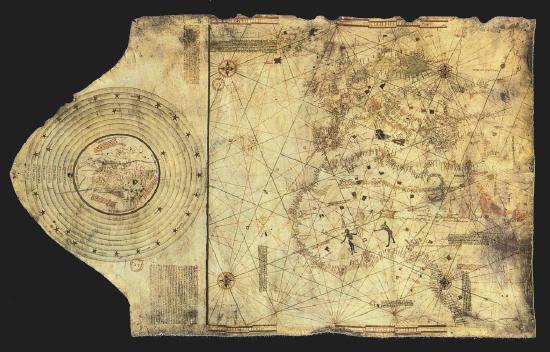
As you’re probably already aware, the 2 AM arrival of Christopher Columbus’s little fleet of three ships in the fall of 1492 has been frequently challenged as the first contact between Europeans and the Americas. Some claims of first contact are better supported by evidence than others. One of the best documented happened nearly five hundred years before Columbus’s arrival.
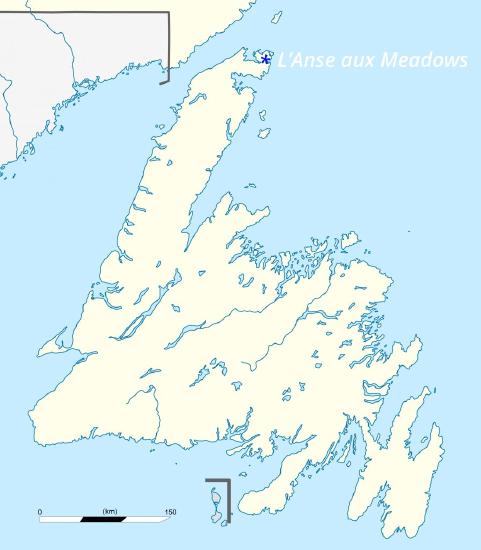
Vikings
At the northern tip of Newfoundland, there’s a Canadian Provincial Park called L’Anse aux Meadows built on the site of a Viking settlement. The Norse have an old legend that Viking hero Leif Erikson founded a colony in a new land they called Vinland. The discovery of the Norse village in 1960 and its acceptance as a UNESCO World Heritage site in 1978 established the Newfoundland colony as the oldest known European site in the Americas, and very probably as the Vinland settlement of Norse legends. The Canadian ruins date from the appropriate period, around 1000 CE. Artifacts found in the remains of eight buildings include farm implements and blacksmith tools. There is also a spinning room containing a soapstone spindle and stone weights that were probably part of a loom. The presence of these artifacts suggests the settlement probably included women, and possibly even families. In other words, the Newfoundland site seems to have been a permanent colony rather than merely a seasonal fishing camp. It was probably an extension of the permanent Viking settlements on Greenland that were the home of Leif Erikson’s father, Erik the Red.

Norse legends say the Vinland colonists were attacked by vicious natives the Vikings called Skraelings, suggesting the native Newfoundland population resisted the newcomers fairly effectively. The Norse also traded with natives, who were very interested in milk the Vikings offered. Since cattle were not indigenous to North America, the presence of cows-milk in the Vinland settlement is another indication it was a long-term colony rather than a temporary camp. The map below, drawn in 1570 in Skálholt, Iceland, shows Great Britain on the bottom right, Iceland in the center, and on the left Grönlandia (Greenland), Helleland (the land of flat stones), Markland (the land of forests) and Skralingeland, which a note in the text says was close to Vinland (the land of meadows). The forests of Markland would have been especially interesting to explorers from Greenland, because the Norse settlements there lacked trees for building.
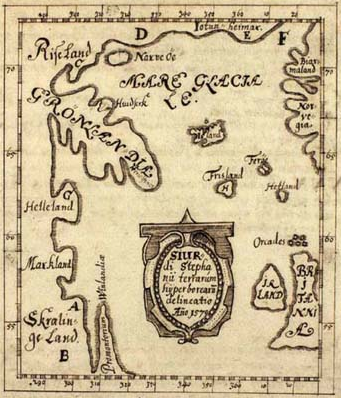
The scarcity of additional Norse sites and the fact that we’re not all speaking Norwegian remind us that the Vikings failed to sustain their settlement in Vinland. While we can probably attribute this failure partly to the resistance of the Skraelings, another decisive factor was a change in global climate. In the middle of the fourteenth century, a four hundred-year period of global cooling known as the Little Ice Age began. Scientists have measured the effects of this climate change in tree rings as far away as Patagonia. Changes in temperature and weather were noticed and recorded in Mayan and Aztec Chronicles, and also in European paintings depicting Londoners drinking, dancing, and skating on the frozen Thames. Pack ice in the North Atlantic expanded southward, making travel to America much more difficult and dangerous. Greenland’s glaciers advanced and shortened growing seasons threatened the five hundred year-old Viking settlements there. By the early 1400s the Norse had abandoned these settlements, and without Greenland it was impossible to sustain a colony in Vinland. This 1747 map of Old Greenland mentions that the coastline where settlements had once been located had become “inaccessible” due to “floating and fixed mountains of ice.” The map even includes the location of a legendary strait that was believed to have once allowed travelers to sail through the center of the continent to North America, but had become “shut up with ice.” It’s interesting to speculate what American history would look like today, if the Vikings hadn’t been defeated by Skraelings and climate change.
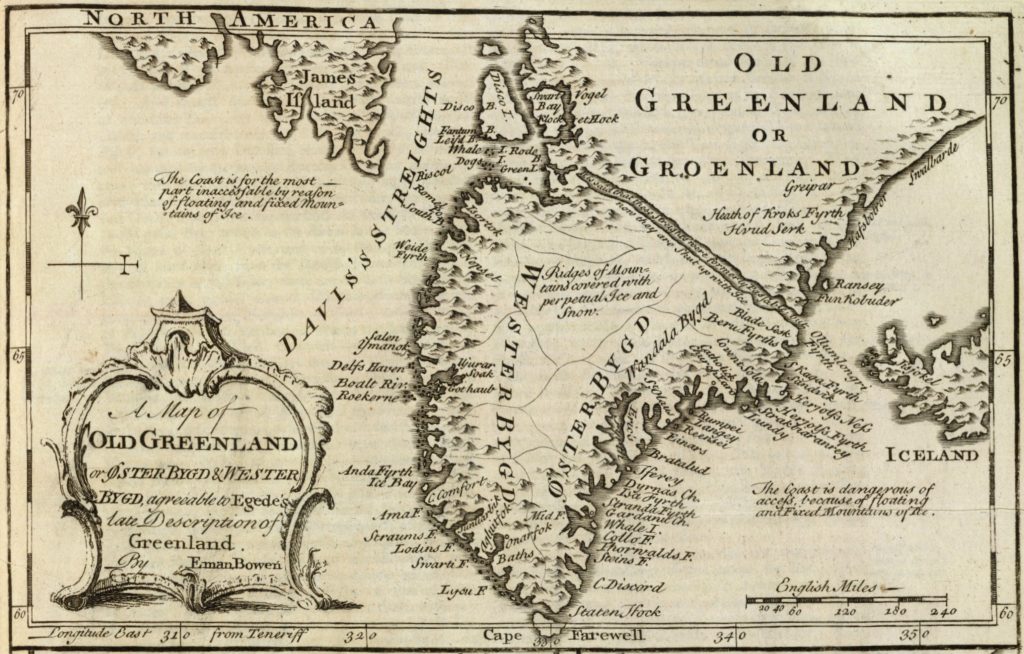
Fishermen
Even during the Little Ice Age, Europeans continued to venture into the icy Atlantic and many probably sailed most of the way to the new world. Basque fishing fleets, for example, began crossing the North Atlantic to visit the Grand Banks in the middle of the fifteenth century. The Banks are areas of shallow water on the edge of the North American continental shelf which are warmed by the Gulf Stream. These warm, shallow waters are an ideal home for bottom-dwelling species like Cod and Lobster. Whoever first discovered the rich fisheries of the Grand Banks off Newfoundland and Georges Bank off Cape Cod, by the late 1400s thousands of Europeans were crossing the ocean to take advantage of the bounty. Venetian explorer Giovanni Caboto (who Anglicized his name to John Cabot) reported in 1497 that Grand Banks cod were so abundant that you could almost walk across the water’s surface on their backs.
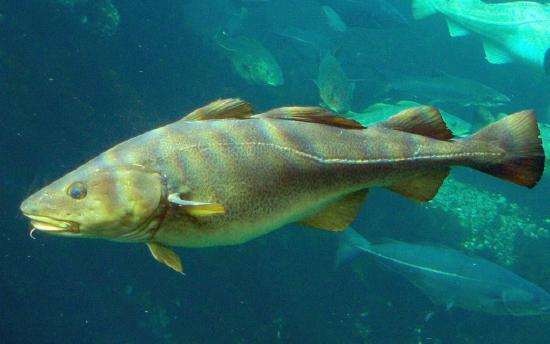
Cod had been fished in the North Atlantic at least since the period of Viking exploration, 800 to 1000 CE. The Vikings and the Basques used similar techniques, catching fish close to shore and then drying them on wooden racks assembled on nearby beaches. They probably landed regularly on the coastlines near the fishing grounds, to dry fish and to replenish their supplies of fresh water. While the locations of prime fishing grounds were closely-guarded trade secrets, by the late 1400s the Portuguese had found out and had begun sending their own fleets to the Grand Banks. Salted Cod is still an important element of Portuguese cuisine, although nowadays they get their fish from Norway.
Until their defeat as part of the Spanish Armada in 1588, Portugal was a North Atlantic naval power. And in the early 1480s, Christopher Columbus was a sailor on the West African coast, where he regularly visited the Portuguese trading post at Elmina. Columbus’s home base was in Lisbon, and his wife was Filipa Moniz Perestrelo, the daughter of the Portuguese governor of Porto Santo, an island off the Atlantic coast of North Africa. It’s very possible that Columbus first heard of the new world from Portuguese sailors retelling the stories of Basque fishermen.
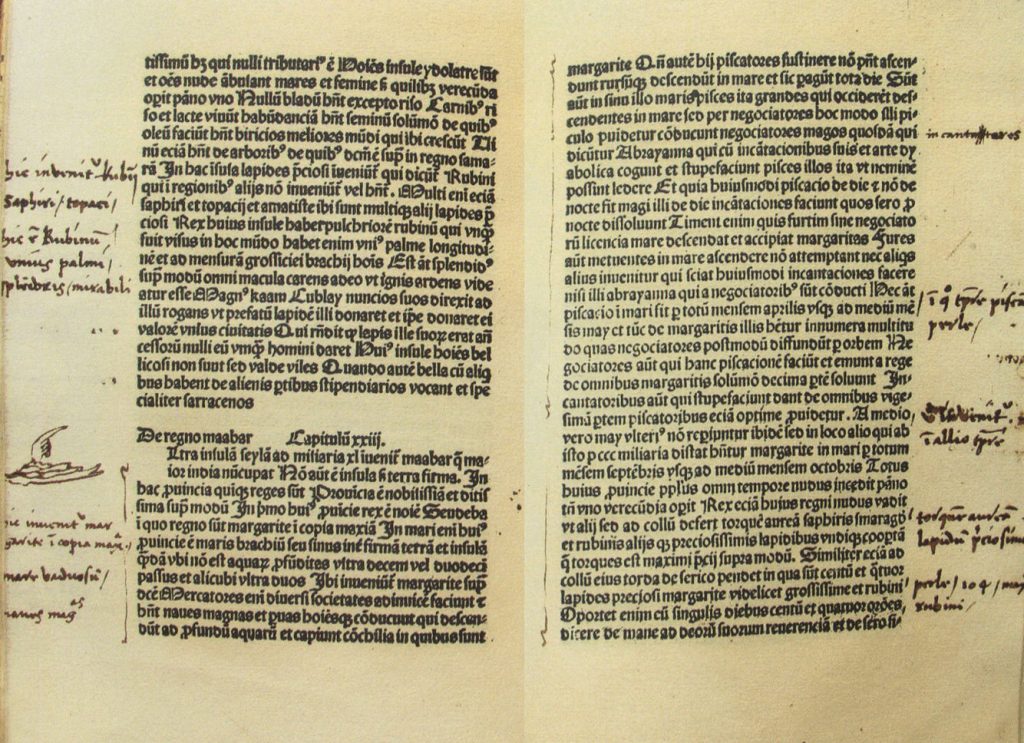
By the end of the fifteenth century, Europe was recovering from the Black Death that had killed between 100 and 200 million people 150 years earlier. Fish from the Grand Banks helped feed growing populations, and Europe entered a period of economic and cultural growth we know as the Renaissance. Merchants were reminded of the existence of wealthy empires in India and China, and began taking advantage of trade routes such as the Silk Road. German blacksmith Johannes Gutenberg developed a printing press, which allowed Christopher Columbus to read The Travels of Marco Polo as a young man in Genoa. The Italian learned to sail and became a navigator working the Atlantic coast of Africa. In 1492 Columbus convinced the monarchs of a newly unified Spain to finance a mission to discover a sea-route to China. King Ferdinand of Aragon and Queen Isabella of Castile had just combined their kingdoms and their armies and completed the “Reconquista,” driving the Muslims out of the Iberian Peninsula after nearly 800 years of war. It is vital to our understanding of Spanish America to remember that the new Iberian nation that turned its attention to exploration in 1492 had been at war constantly since the dark ages.
As you would expect, it’s very difficult to be certain about the exact population of the world at the end of the fifteenth century. There are a number of competing estimates, but the consensus is that there were probably about 500 million people alive in 1492, and that slightly over a third of them lived in Asia. The other two-thirds seem to have been about evenly split between Europe, Africa, and the Americas – although there’s still a great deal of controversy surrounding those numbers. Even so, if we take a conservative number from the middle of the range of estimates, we get an American population of 80 to 100 million just before Columbus and his fellow explorers arrived. All but 2 or 3 million of those Native Americans lived in Central and South America, which were much more densely populated than North America.
Maps and Bias
Video \(\PageIndex{1}\): Maps & Bias: https://www.youtube.com/watch?v=BZOCogf1t2A
The Columbian Exchange
Columbus arrived in the Caribbean in October 1492 and explored until late December. His flagship, the Santa Maria, ran aground on Hispaniola on December 25th and had to be abandoned. With permission of the local chief, Columbus left 39 sailors behind in a settlement he named La Navidad. He returned to Europe with two ships, a few Indians, some gold, and specimens of native species including turkeys, pineapple, and tobacco. Arriving in Barcelona in mid-March, Columbus was celebrated as a hero.
It is often mentioned that Columbus believed he had reached Asia, and he did make that claim in his extravagant “Letter on the First Voyage.” But this letter was the explorer’s report to his royal sponsors, and he wanted very badly to be sent back again. Columbus wrote “Hispaniola is a miracle…both fertile and beautiful…the harbors are unbelievably good and there are many wide rivers the majority of which contain gold.” Whether or not Columbus understood he was reporting on previously unknown lands, he definitely got people excited about the places he had visited.
When other European explorers reached America they were equally amazed. People throughout Europe read exciting traveler’s accounts like Amerigo Vespucci’s 1504 best-seller, Mundus Novus, which actually coined the term New World and made it clear for anyone who might still be confused, that these lands were not Asia but a previously unknown continent. Like Columbus, the explorers carried back to Europe not only stories of wealthy civilizations and legends of cities of gold, but samples of native plants, animals, and captive Indians. And when Columbus himself returned to the Caribbean, he brought with him European plants and animals that he transplanted into the promising new environment.
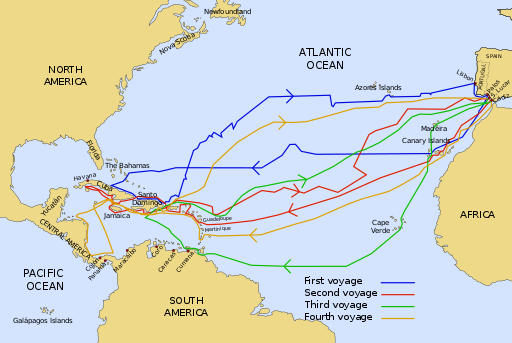
Europeans realized not only that American food crops could be brought back to Europe, but also that the Americas were a great place to grow many of Europe’s traditional foods. Columbus returned to the Caribbean in 1495 with 17 ships, 1,200 men, and according to his diaries, “seeds and cuttings for the planting of wheat, chickpeas, melons, onions, radishes, salad greens, grape vines, sugar cane, and fruit stones for the founding of orchards.” Other old-world crops that thrived in the Americas included coffee and bananas, which were brought from the Canary Islands in 1516. The Spanish had introduced sugar cultivation to the Canary Islands in the early fifteenth century, so it only made sense to try the plant in the tropical paradise their explorers had discovered across the Atlantic. Cattle were delivered to Spanish conquistadors in Mexico in 1521. By 1614, according to one of the conquistador chronicles, “the residents of Santiago [in Chile, over 4,000 miles away] possessed 39,250 head,” as well as flocks totaling 623,825 sheep. According to local traditions, when Pizarro first invaded Peru in 1524, he crossed the Andes with only eighty fighting men and forty horses, but with over 2,000 pigs.
Most of the really significant Eurasian species brought to the Americas had already been introduced by the Spanish by the early 1500s, long before North American settlement began. Even species like the wild horses of the American West that would transform Plains Indian culture were escapees from the herds of the conquistadors. As mentioned earlier, the Americas were home to very few large mammal species, and most could not be domesticated. Domestication is only successful with social animals that will accept a human as the leader of their herd or pack. Nearly all the species humans have successfully domesticated, the familiar residents of the modern farmyard, originated in Europe and Asia. These include goats, sheep, cows, horses, pigs and chickens. Eurasians began domesticating these animals between ten and fifteen thousand years ago. This was just a little too late for the Beringians to bring domesticated animals with them into North America. In any case, the Beringians were tundra hunters, not temperate-zone pastoralists. But as any good hunter would, the Beringians had brought their dogs.
Historians call the transfer of plants and animals that began with fifteenth and early-sixteenth century European-American re-contact the Columbian exchange. The directions of these transfers and their effects on the environments and people of Europe and the Americas shaped the modern world we live in. American maize, potatoes, and cassava fed growing European and Asian populations, allowing the building of new cities and industries. European animals such as pigs, sheep, chicken, and cattle thrived in the Americas, allowing both Natives and Europeans to expand and change their cultures. But the most significant change of all was the largely accidental transfer of viruses and bacteria from Europeans to Americans, which caused the deaths of possibly 90% of the native American population.
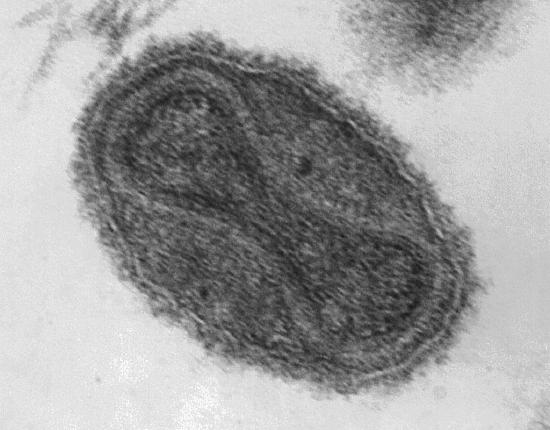
When prehistoric Eurasians began living in close contact with the species they domesticated, the people changed as well as the animals. We’ve already noted how Europeans and some Africans developed a mutation that allowed them to digest cows-milk. Another change domesticated animals brought to humans, which was largely unrecognized by historians until recently, was disease. Most of humanity’s major diseases originated in animals and crossed from domesticated species to their human keepers. Whooping cough and influenza came from pigs; measles and smallpox from cattle; malaria and avian flu from chickens. The people who domesticated these species and lived with the animals for generations co-evolved with them. Animal diseases became survivable when people developed antibodies and immunity. Without inherited this protection, even a routine childhood disease such as chickenpox would be devastating.
Population Disaster
The introduction of a disease into an area without immunity is called a virgin soil epidemic. Such epidemics had happened in Eurasia, when the Romans spread smallpox into the populations they conquered, and in Europe when the expanding Mongols introduced bubonic plague. The Black Death killed probably half the population of Europe in the fourteenth century, reducing world population by over a hundred million. Virgin soil epidemics happened in the Americas when explorers and colonists introduced Eurasian diseases to native Americans who had been isolated for thousands of years. The Americans had no immunities, and even diseases that were no longer deadly to Europeans killed millions. The Eurasian diseases that attacked native populations included smallpox, measles, chickenpox, influenza, typhus, cholera, typhoid, diphtheria, bubonic plague, scarlet fever, whooping cough, and malaria.
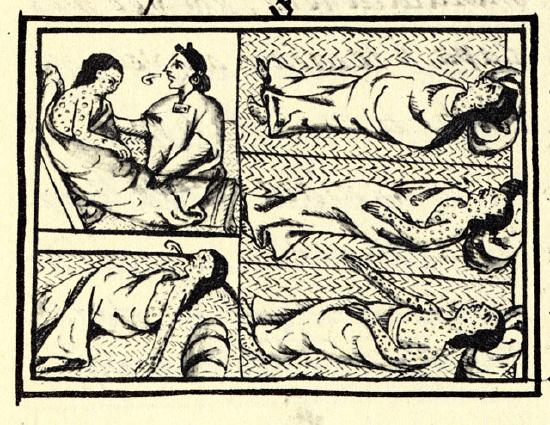
The impact of these Eurasian diseases on Americans was one of human history’s most severe population disasters. Even the Black Death didn’t kill as large a percentage of Europeans. For example, there were probably a million people living on the Caribbean island of Hispaniola in 1492 when the Columbus left his 39 sailors in La Navidad. By 1548, there were only 500 Natives left alive. The populations of other Caribbean islands were similarly wiped out. Whole civilizations disappeared, but this was not only a tragedy for the cultures that vanished. It began a cycle of violence that became central to American history. Because once there were no natives left to work on European sugar plantations, African slaves became crucial to the survival of the West Indies economy.
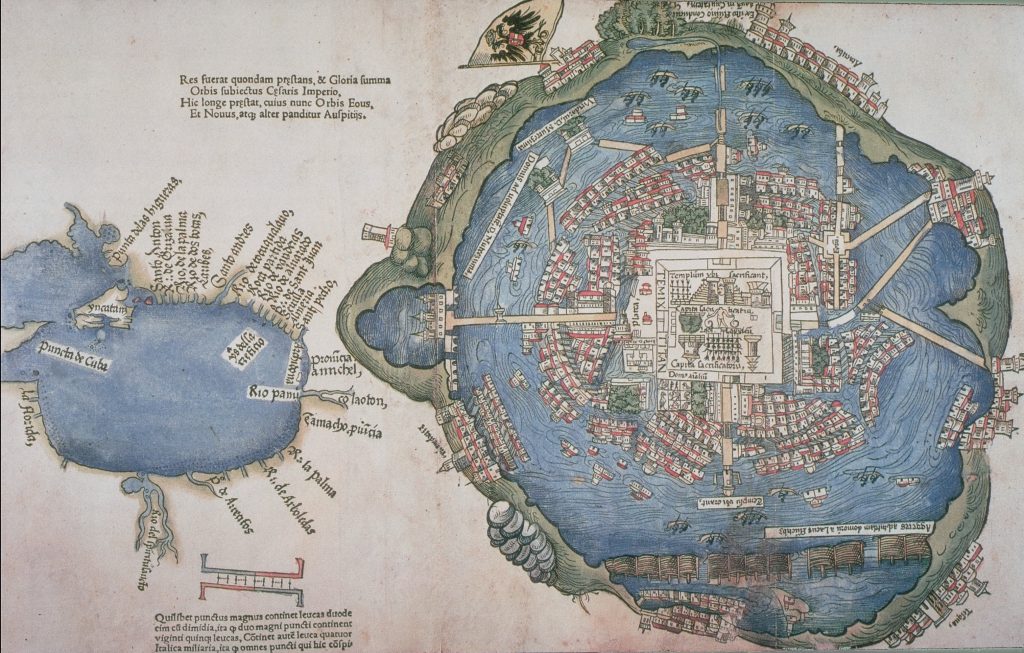
The greater population densities of Central and South America helped contagious diseases spread more quickly there. Heavily traveled roads in central Mexico actually spread disease beyond the areas that had been reached by Spanish explorers. Cities were wiped out that had never seen a white man. The population of the Aztec heartland dropped from about 25 million on the eve of the Spanish conquest in 1519 to just under 17 million a decade later. That means one out of every three people died in just ten years. After another decade the Aztec population was reduced to about 6 million. Three out of four people in the Aztec world disappeared in 20 years. Imagine writing a list of all the people you know, and then randomly crossing off three out of every four names.
By 1580, the Aztec empire had been hollowed out to less than 2 million people, from a starting point of 25 million. Isolated rural communities may have been a little luckier than central cities on trade routes, which were often completely emptied. The city of Zempoala, for example, held 100,000 Aztec citizens in 1519. There were only 25 native inhabitants in 1550.
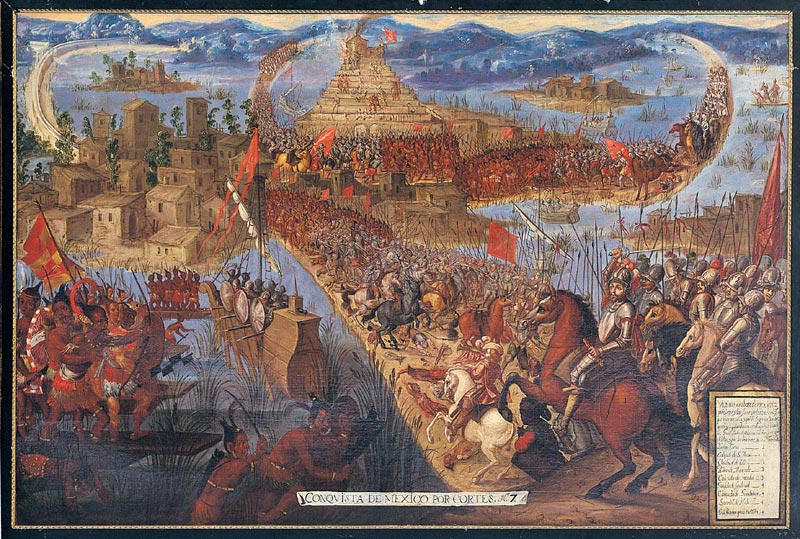
The Inca Empire in the Andes suffered the same fate. 90% of the South Americans died, and they started dying before the white men arrived, which caused confusion and dismay. When Pizarro crossed the Andes with his eighty conquistadors and 2000 pigs, he found social chaos. Huayna Capac, the Inca leader who had extended the empire into Chile and Ecuador, had died of smallpox. His two sons fought a brutal civil war for control of the empire, the younger son Atahualpa finally defeating and assassinating his older brother Huáscar. The war and the weakness of the reduced Inca population gave Pizarro the opportunity he needed to capture and kill Atahualpa in 1533, ending the Inca empire.
Hernando De Soto landed an expedition in Florida in 1539 and explored territory now in the states of Georgia, South Carolina, North Carolina, Tennessee, Alabama, Mississippi, and Oklahoma. Everywhere he went, the conquistador reported the land was “thickly settled with large towns.” De Soto didn’t stay. He died of fever in Louisiana in 1542, and the region wasn’t visited again by Europeans until the French aristocrat, La Salle, traveled down the Mississippi River in 1670. Where De Soto had seen fortified towns, La Salle saw no one. The entire region was empty, and the French explorer traveled hundreds of miles without passing a single village. Historians were unaware until recently that the American south had once been heavily populated with natives before the arrival of contagious Spanish explorers and missionaries.
The destruction of native empires and the rapid disappearance of the American population was unplanned. The overwhelming success of the conquistadors was an unanticipated consequence of re-contact between two isolated descendant groups of the Eurasian plains hunters we discussed in Chapter One. Sixteenth-century Europeans had virtually no understanding of the causes of disease. They had no idea that exploring the Americas or carrying their animals to the New World would eliminate nine out of ten people in a population that had been the size of Europe’s. But they knew how to take advantage of their enemy’s misfortunes. The rapid destruction of American populations and cultures created opportunities for Europeans to colonize the Americas that they wouldn’t have otherwise enjoyed. We’ll take a closer look at this colonization in Chapter Three. But in the meantime, what happened to Europe?
Video\(\PageIndex{2}\): Charles C. Mann: The Impact of Europeans on America. https://youtu.be/Dcoz2tQc8-w
Pieces of Eight
As previously mentioned, American staple crops were introduced in Europe, where they sparked a population boom. Many plant species developed by Americans are still crucial to the world economy, including not only maize, potatoes, and cassava, but tomatoes, sweet potatoes, cacao, chili peppers, natural rubber, tobacco, and vanilla. Quinine, a medicine made from the bark of the Peruvian cinchona tree, was effective treating malaria and helped open the tropics to European colonization. Eurasian plants like sugar, soybeans, oranges, bananas, and rice (which probably reached America from Africa along with enslaved women who were experts growing it) were also extensively cultivated in the Americas for shipment back to European markets. Exports of native and transplanted crops helped feed growing cities and freed up workers for Europe’s new industries. Without American foods, there might have been no European industrial revolution.
The other American product rapidly sent across the Atlantic to Europe and across the Pacific to Asia was money. Although Europeans never found El Dorado, the legendary Indian city of gold, they did find a fair amount of gold. And they found even more silver. For example, the Bolivian city of Potosí, located in the Andes mountains at an elevation of 13,420 feet, is said to be the world’s highest city. Potosí was established by the Spanish in 1542 on the site of a long-standing native mining village at the foot of the Cerro Rico, which is a literal mountain of silver. Potosí has a current population of about 165,000. That’s almost identical to Potosí’s population in 1660, when the mining city was larger than Seville, Madrid, or Rome, and when the combined population of all the North American colonies was only about 75,000. Spanish silver coins often called “pieces of eight” from the Cerro Rico and similar mines in Zacatecas, Mexico, were so plentiful that they became the international currency of Europe and much of Asia. Once again, without the money minted in Latin America, there might have been no global commercial boom to finance the industrial revolution. And Potosí’s story isn’t over yet. Although most of the silver was taken out of the mountain centuries ago, the Cerro Rico is still being worked by Bolivian children whose story is told in the award-winning documentary, The Devil’s Miner, which you can view on the web if you’re interested in learning more.
Video \(\PageIndex{3}\): The Devil's Miner Clips: https://youtu.be/Mjs3ktoabF8
As a result of the Columbian exchange, European colonists in the Americas frequently found fields waiting for their farmers and herds of game animals waiting for their hunters. In Central and South America, the Spanish built cities like Mexico City and Cusco right on top of the native cities they replaced. Since Spanish colonists were generally soldiers and very few Spanish women came to the early colonies, there was a lot of racial mixing. Most of the countries of Latin America are built on mixed or mestizo populations; so much so that it became important for the colonists to try to make distinctions between all the various types of people they believed made up their societies. Although these distinctions were initially used to uphold the power of the group at the top, in the long run many of these Euro-American populations have developed strong ethnic identities. A similar process happened to our north, in New France. There were only about twenty-five hundred French people in Quebec by 1663. Most of them were voyageurs, fur traders who went into the northern forests to make their fortunes. Voyageurs married local Indian women, and their Canadian descendants are now recognized as a distinct ethnic group called Métis.
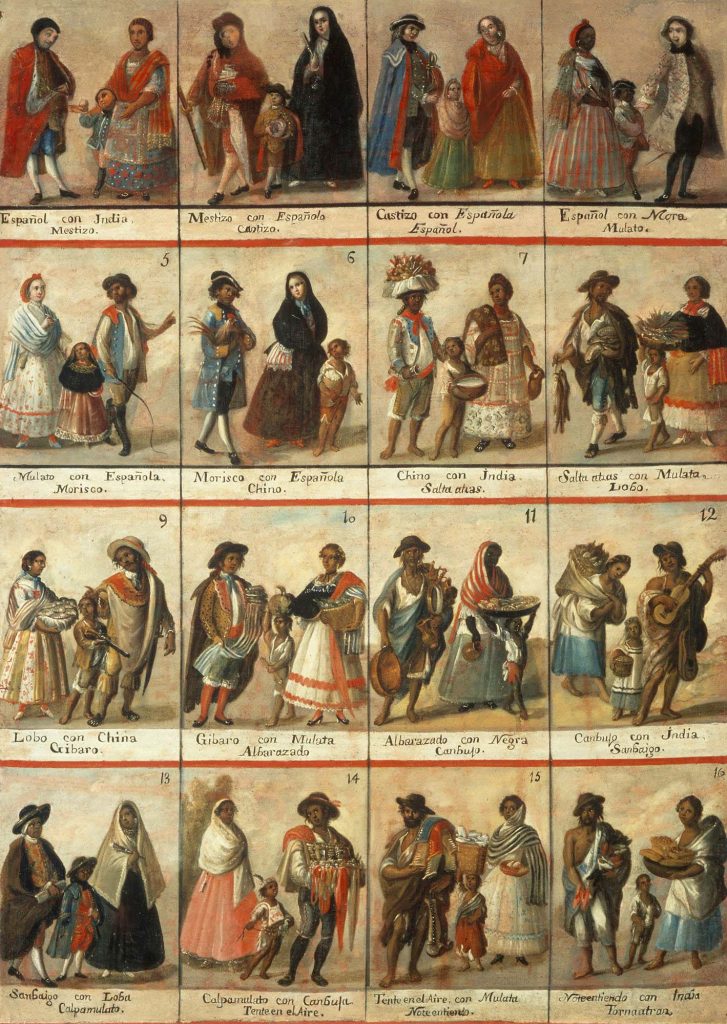
In the Dutch and English colonies that became the United States, the races kept mostly separate. Many settlers migrated with their entire families to settle the British colonies. But the racial segregation that developed in the colonies that became the United States was not inevitable. If the people who had settled the US had mixed more with the natives, genetically and culturally, would our culture and our relationship with our environment have been different?
Changing History
History changes when new evidence and new interpretations challenge long-held beliefs. But the process isn’t always easy. Historian Alfred W. Crosby first addressed the idea that disease was a factor in American history in a 1967 journal article called “Conquistadors y Pestilencia.” Crosby later said he “stumbled into environmental history through the backdoor of epidemiology.” Of course, there was no such field when he wrote, and Crosby helped create it.
“Conquistadors y Pestilencia” re-examines the Spanish conquest. “How did Hernán Cortés do it?” Crosby asked. “Well, he didn’t. Old World smallpox did.”
“When the isolation of the Americas was broken, and Columbus brought the two halves of this planet together, the American Indian met for the first time his most hideous enemy – not the white man or his black servant, but the invisible killers which these men brought in their blood and breath,” Crosby wrote in 1967. Over then next couple of years, Crosby expanded the article into a book whose title became the accepted name of this phenomenon: The Columbian Exchange.
Crosby tried for several years to interest publishers in his radical thesis, without success. He sent the manuscript to a dozen academic presses. The most memorable rejection letter Crosby received consisted of a single word, “Nonsense!” Crosby finally landed an unlikely publisher in 1971 when an antiquarian reprint press asked if he had anything book-length he’d like to see in print. The Columbian Exchange was published in 1972.
Reception of the book was favorable, although some of the reviewers failed to grasp Crosby’s point. One review in a major historical journal described disease decimating both old world and new world populations. Crosby didn’t say this, and it wasn’t true of the biological exchange he was writing about. Epidemics had indeed decimated European and Asian populations in the past. But not following 1492. The only disease that may have crossed from the new world to the old, Crosby had claimed, was syphilis. Although a killer, syphilis wasn’t immediately fatal, and it did nowhere near the damage to Europe that smallpox, plague, and other Eurasian diseases did to native American populations.
Over time, Crosby’s thesis attracted historians interested in biological and ecological issues, and The Columbian Exchange became one of the founding texts of a new field. Unlike mainstream historians, many of whom rejected the pessimistic conclusion of Crosby’s book, environmental historians were willing to consider the possibility that the Columbian exchange was not over. Crosby claimed the events of the sixteenth century were “simply an early phase in a slide toward worldwide biological homogeneity,” and that this process is “continuing, even accelerating.”
Further Reading
- Alfred W. Crosby, The Columbian Exchange: Biological and Cultural Consequences of 1492. 1972.
- Shawn William Miller, An Environmental History of Latin America. 2007.
Media Attributions
- ColombusMap by Bartolomeo and Cristoforo Colombo © Public Domain
- Canada_Newfoundland_location_map by NordNordWest © CC BY-SA (Attribution ShareAlike)
- I._E._C._Rasmussen_-_Sommernat_under_den_Grønlandske_Kyst_circa_Aar_1000 by Carl Rasmussen © Public Domain
- Skálholt-Karte by Sigurd Stefánsson - Copy by Jörg Schulz © Public Domain
- Old_Greenland_1747 by Emanuel Bowen © Public Domain
- Gadus morhua by Hans-Petter Fjeld © CC BY-SA (Attribution ShareAlike)
- ColombusNotesToMarcoPolo © Public Domain
- 512px-Viajes_de_colon_en.svg by Phirosiberia © CC BY-SA (Attribution ShareAlike)
- Smallpox_virus_virions_TEM_PHIL_1849 by Dr. Fred Murphy; Sylvia Whitfield, CDC © Public Domain
- FlorentineCodex_BK12_F54_smallpox by Bernardino de Sahagún © Public Domain
- Map_of_Tenochtitlan,_1524 by Friedrich Peypus © Public Domain
- The_Conquest_of_Tenochtitlan © Public Domain
- Casta_painting_all © Public Domain


